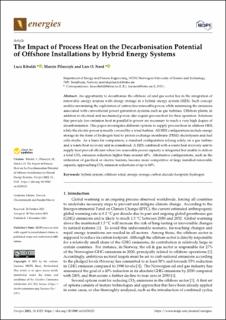| dc.contributor.author | Riboldi, Luca | |
| dc.contributor.author | Pilarczyk, Marcin | |
| dc.contributor.author | Nord, Lars O. | |
| dc.date.accessioned | 2022-02-28T14:29:28Z | |
| dc.date.available | 2022-02-28T14:29:28Z | |
| dc.date.created | 2021-12-06T09:19:04Z | |
| dc.date.issued | 2021 | |
| dc.identifier.issn | 1996-1073 | |
| dc.identifier.uri | https://hdl.handle.net/11250/2981794 | |
| dc.description.abstract | An opportunity to decarbonise the offshore oil and gas sector lies in the integration of renewable energy sources with energy storage in a hybrid energy system (HES). Such concept enables maximising the exploitation of carbon-free renewable power, while minimising the emissions associated with conventional power generation systems such as gas turbines. Offshore plants, in addition to electrical and mechanical power, also require process heat for their operation. Solutions that provide low-emission heat in parallel to power are necessary to reach a very high degree of decarbonisation. This paper investigates different options to supply process heat in offshore HES, while the electric power is mostly covered by a wind turbine. All HES configurations include energy storage in the form of hydrogen tied to proton exchange membrane (PEM) electrolysers and fuel cells stacks. As a basis for comparison, a standard configuration relying solely on a gas turbine and a waste heat recovery unit is considered. A HES combined with a waste heat recovery unit to supply heat proved efficient when low renewable power capacity is integrated but unable to deliver a total CO2 emission reduction higher than around 40%. Alternative configurations, such as the utilization of gas-fired or electric heaters, become more competitive at large installed renewable capacity, approaching CO2 emission reductions of up to 80%. | en_US |
| dc.language.iso | eng | en_US |
| dc.publisher | MDPI | en_US |
| dc.rights | Navngivelse 4.0 Internasjonal | * |
| dc.rights.uri | http://creativecommons.org/licenses/by/4.0/deed.no | * |
| dc.title | The Impact of Process Heat on the Decarbonisation Potential of Offshore Installations by Hybrid Energy Systems | en_US |
| dc.type | Peer reviewed | en_US |
| dc.type | Journal article | en_US |
| dc.description.version | publishedVersion | en_US |
| dc.source.volume | 14 | en_US |
| dc.source.journal | Energies | en_US |
| dc.source.issue | 23 | en_US |
| dc.identifier.doi | https://doi.org/10.3390/en14238123 | |
| dc.identifier.cristin | 1964889 | |
| dc.relation.project | Norges forskningsråd: 281986 | en_US |
| cristin.ispublished | true | |
| cristin.fulltext | original | |
| cristin.qualitycode | 1 | |

